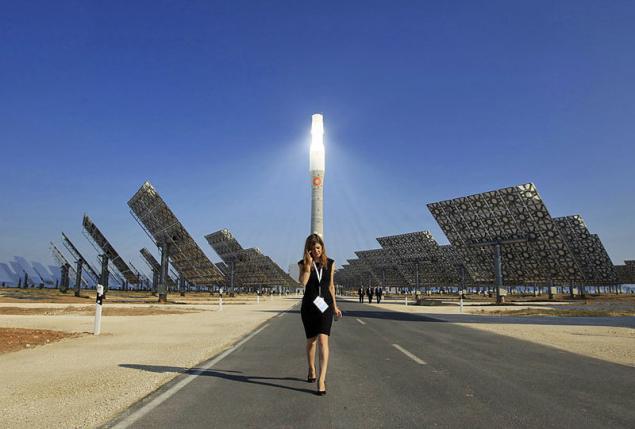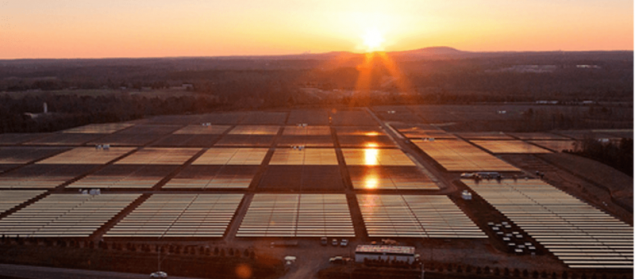662
energy generation on modern gelioelektrostantsiyah
Solar energy programs have been adopted in more than 70 countries - from northern Scandinavia to the parched deserts of Africa. Devices that use the sun's energy, are designed for heating, lighting and ventilation of buildings, skyscrapers, water desalination and electricity production. Such devices are used in various industrial processes. There were vehicles with a "solar-driven": motor boats and yachts, solntselety and airships with solar panels. Solntsemobili yesterday, compared with a funny avtoattraktsionom today cross countries and continents at a rate almost equal to conventional cars.

Concentrators of solar radiation. Since childhood, many remember that through the collective lens from sunlight can ignite the paper. The lenses are not used industrial plants: they are heavy, expensive and difficult to manufacture
. It focuses the sun's rays can be and with the help of a concave mirror. It is the main part of solar concentrator, the device in which parallel sunbeams collected by the concave mirror. If placed in the focus of mirror tube with water, it will heat up. This is the principle of direct effect of solar inverters.
Most effectively they can be used in the southern latitudes, but in the middle lane they are used. Mirrors are used in installations or traditional - glass or polished aluminum
. Technically, the concentration can be carried out through a variety of optical elements-mirrors, lenses, optical fibers, etc., But in practice it is advisable to use only the reflectors at high levels of the concentrated radiation power.
The main indicator of the energy hub of the solar radiation is the concentration ratio, which is defined as the ratio of the average density of the concentrated radiation to the density of radiation flux incident on the reflective surface provided accurate orientation to the sun.
Concentrating ability of real systems is significantly lower Kpred (Kpred = 46 160), but is also determined primarily hub geometry and angle of the solar disk radius. It is essential to it and affect the reflectivity of the mirror surface, particularly in the case of multiple reflections.

Concentration of high-grade systems must be configured to close the second form surfaces of revolution poryadka- parabaloida, ellipsoid, or giperbaloida polusfery.Tolko in this case can be achieved the radiation density in the hundreds and thousands times the solar constant.
The most efficient solar concentrators are in the form:
cylindrical paraboloid;
paraboloid of revolution;
plano-linear Fresnel lens.
Parabaloidnaya configuration has a distinct advantage over other forms of largest concentrating ability. Therefore, it is they are so widespread in geliotehnicheskih systems.
The optimal angle of disclosure of real parabaloidnyh hubs, as opposed to the ideal angle parabaloid. a hub (45 deg.), close to 60 degrees.
Solar energy can be converted directly into mechanical. It uses a Stirling engine (Mot. External combustion, an example of a steam locomotive). If the focus of a parabolic mirror with a diameter of 1, 5 m to establish a dynamic transducer, working on the Stirling cycle, obtained enough power to raise from the depth of 20 meters of 2 cubic meters of water per hour.
The actual solar plano-linear Fresnel lens is rarely used because of its high cost.
The first attempts to use solar power on a broad commercial basis, belong to the 80 th year of our stoletiya.Krupneyshih success in this area has made firm Loose Industries (USA). She in December 1989 put into operation solar-gas plant with a capacity of 80 MW.
Here in California, in 1994 introduced another 480 MW of electrical power, and, the cost of 1 kWh of energy - 7 ... 8 cents. This is lower than most conventional plants. (US Nuclear Station ~ 15 cents per 1 kW.). At night and in the winter gives you energy, mainly gas, and in the summer during the day - the sun. Loose Industries Company in the solar-gas power plant in California uses a system of cylindrical-parabolic reflector in a long trough. In its focus with the coolant tube passes - biphenyl, heated to 350 ° C. The trough is rotated to track the sun only around one axis (rather than two, as flat heliostats). It is possible to simplify the sun tracking system.

The power plant in California has shown that the gas and the sun as the main energy source of the near future, can effectively complement each other. Therefore, the conclusion is not accidental that as a solar partner must serve a different kind of liquid or gaseous fuel.
The most likely "candidate" is hydrogen. Reverse the process of transferring energy from hydrogen into electric energy is carried out by special devices - fuel cells
. The conclusion is that the most cost-effective possibility of using solar energy, which can be seen today - to direct it for secondary forms of energy in sunny areas of the world. The resulting liquid or gaseous fuel can be pumped by pipeline or tanker to transport to other areas.
Preparation vodoroda.Pri electrolysis, however, most of the power is lost as heat when a current flows through the electrolyte. In plants operating on this principle, to produce one cubic meter of hydrogen is required ... 4 5 kilowatt-hours of electricity, which is quite expensive - for the production of an equivalent amount of gasoline calorific capacity costs three times cheaper. Meanwhile, a lot of trouble in the areas of gas fields associated with emissions of hydrogen sulfide or its processing products to the atmosphere. Hydrogen sulfide is often still considered harmful impurity, makes it possible for gasoline than you can remember the story in the early nineteenth century. First of all, oil - "groundnut oil" as it was then called, began to allocate refined foods - learned how to get kerosene and gasoline
. Kerosene has been applied directly to the emergence of a kerosene lamp. The fate of gasoline was more complicated. For nearly a hundred years, this flammable liquid has been one of the most dangerous waste oil. Gasoline is getting more and more difficult from him was to get rid of. By the early twentieth century, the weight of the gasoline being destroyed hundreds of thousands of tons per year. Announces a competition - who will find the best way to waste disposal. Only the invention of the internal combustion engine has opened up the real scope of the gasoline.
Now industry best sulfide is oxidized by atmospheric oxygen Clauss method developed in the last century, and is prepared with sulfur and hydrogen is bonded to oxygen. The disadvantage of this, by the way, very expensive process is obvious: the hydrogen sulfide is removed from only the sulfur and the hydrogen goes into the water. Therefore we conducted by hydrogen sulfide dissociation experiments in the plasma to a single step to obtain two products: hydrogen and sulfur fused
. For this hydrosulphuric plasma is caused to rotate with the transonic speed. The resulting sulfur particles in the plasma torch are carried out while the reaction volume over a time insufficient for the reverse reaction. The centrifugal effect allows to achieve significant plasma chemical system deviation from thermodynamic equilibrium and reduce energy consumption for the production of hydrogen cubic meters to tens of watts. This is cheaper hydrogen electrolysis is about 15 times, and it is already possible to be widely used in power generation and in industry.

Concentrators of solar radiation. Since childhood, many remember that through the collective lens from sunlight can ignite the paper. The lenses are not used industrial plants: they are heavy, expensive and difficult to manufacture
. It focuses the sun's rays can be and with the help of a concave mirror. It is the main part of solar concentrator, the device in which parallel sunbeams collected by the concave mirror. If placed in the focus of mirror tube with water, it will heat up. This is the principle of direct effect of solar inverters.
Most effectively they can be used in the southern latitudes, but in the middle lane they are used. Mirrors are used in installations or traditional - glass or polished aluminum
. Technically, the concentration can be carried out through a variety of optical elements-mirrors, lenses, optical fibers, etc., But in practice it is advisable to use only the reflectors at high levels of the concentrated radiation power.
The main indicator of the energy hub of the solar radiation is the concentration ratio, which is defined as the ratio of the average density of the concentrated radiation to the density of radiation flux incident on the reflective surface provided accurate orientation to the sun.
Concentrating ability of real systems is significantly lower Kpred (Kpred = 46 160), but is also determined primarily hub geometry and angle of the solar disk radius. It is essential to it and affect the reflectivity of the mirror surface, particularly in the case of multiple reflections.

Concentration of high-grade systems must be configured to close the second form surfaces of revolution poryadka- parabaloida, ellipsoid, or giperbaloida polusfery.Tolko in this case can be achieved the radiation density in the hundreds and thousands times the solar constant.
The most efficient solar concentrators are in the form:
cylindrical paraboloid;
paraboloid of revolution;
plano-linear Fresnel lens.
Parabaloidnaya configuration has a distinct advantage over other forms of largest concentrating ability. Therefore, it is they are so widespread in geliotehnicheskih systems.
The optimal angle of disclosure of real parabaloidnyh hubs, as opposed to the ideal angle parabaloid. a hub (45 deg.), close to 60 degrees.
Solar energy can be converted directly into mechanical. It uses a Stirling engine (Mot. External combustion, an example of a steam locomotive). If the focus of a parabolic mirror with a diameter of 1, 5 m to establish a dynamic transducer, working on the Stirling cycle, obtained enough power to raise from the depth of 20 meters of 2 cubic meters of water per hour.
The actual solar plano-linear Fresnel lens is rarely used because of its high cost.
The first attempts to use solar power on a broad commercial basis, belong to the 80 th year of our stoletiya.Krupneyshih success in this area has made firm Loose Industries (USA). She in December 1989 put into operation solar-gas plant with a capacity of 80 MW.
Here in California, in 1994 introduced another 480 MW of electrical power, and, the cost of 1 kWh of energy - 7 ... 8 cents. This is lower than most conventional plants. (US Nuclear Station ~ 15 cents per 1 kW.). At night and in the winter gives you energy, mainly gas, and in the summer during the day - the sun. Loose Industries Company in the solar-gas power plant in California uses a system of cylindrical-parabolic reflector in a long trough. In its focus with the coolant tube passes - biphenyl, heated to 350 ° C. The trough is rotated to track the sun only around one axis (rather than two, as flat heliostats). It is possible to simplify the sun tracking system.

The power plant in California has shown that the gas and the sun as the main energy source of the near future, can effectively complement each other. Therefore, the conclusion is not accidental that as a solar partner must serve a different kind of liquid or gaseous fuel.
The most likely "candidate" is hydrogen. Reverse the process of transferring energy from hydrogen into electric energy is carried out by special devices - fuel cells
. The conclusion is that the most cost-effective possibility of using solar energy, which can be seen today - to direct it for secondary forms of energy in sunny areas of the world. The resulting liquid or gaseous fuel can be pumped by pipeline or tanker to transport to other areas.
Preparation vodoroda.Pri electrolysis, however, most of the power is lost as heat when a current flows through the electrolyte. In plants operating on this principle, to produce one cubic meter of hydrogen is required ... 4 5 kilowatt-hours of electricity, which is quite expensive - for the production of an equivalent amount of gasoline calorific capacity costs three times cheaper. Meanwhile, a lot of trouble in the areas of gas fields associated with emissions of hydrogen sulfide or its processing products to the atmosphere. Hydrogen sulfide is often still considered harmful impurity, makes it possible for gasoline than you can remember the story in the early nineteenth century. First of all, oil - "groundnut oil" as it was then called, began to allocate refined foods - learned how to get kerosene and gasoline
. Kerosene has been applied directly to the emergence of a kerosene lamp. The fate of gasoline was more complicated. For nearly a hundred years, this flammable liquid has been one of the most dangerous waste oil. Gasoline is getting more and more difficult from him was to get rid of. By the early twentieth century, the weight of the gasoline being destroyed hundreds of thousands of tons per year. Announces a competition - who will find the best way to waste disposal. Only the invention of the internal combustion engine has opened up the real scope of the gasoline.
Now industry best sulfide is oxidized by atmospheric oxygen Clauss method developed in the last century, and is prepared with sulfur and hydrogen is bonded to oxygen. The disadvantage of this, by the way, very expensive process is obvious: the hydrogen sulfide is removed from only the sulfur and the hydrogen goes into the water. Therefore we conducted by hydrogen sulfide dissociation experiments in the plasma to a single step to obtain two products: hydrogen and sulfur fused
. For this hydrosulphuric plasma is caused to rotate with the transonic speed. The resulting sulfur particles in the plasma torch are carried out while the reaction volume over a time insufficient for the reverse reaction. The centrifugal effect allows to achieve significant plasma chemical system deviation from thermodynamic equilibrium and reduce energy consumption for the production of hydrogen cubic meters to tens of watts. This is cheaper hydrogen electrolysis is about 15 times, and it is already possible to be widely used in power generation and in industry.
Your emotions - the vibrating indicator balance or imbalance
Investments in solar energy will reach $ 3, $ 4 trillion by 2040
























